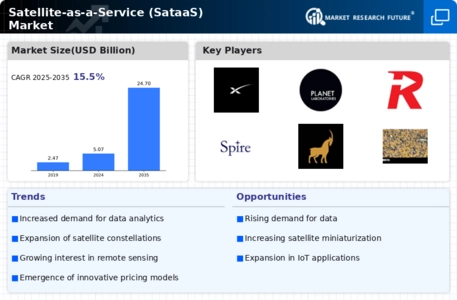Top Industry Leaders in the Satellite-as-a-Service SataaS Market

The Satellite-as-a-Service (SataaS) market is a pivotal segment within the satellite industry, revolutionizing the way satellite capabilities are delivered and accessed. A thorough examination of the competitive landscape reveals key players, their strategies, and recent developments in this dynamic market.
Strategies Adopted By Key Players Satellite-as-a-Service (SataaS) Market
Key players in the Satellite-as-a-Service market include SES S.A., Iridium Communications, OneWeb, Spire Global, and Amazon Web Services (AWS). These companies play a vital role in providing satellite services on a subscription or on-demand basis, enabling customers to access satellite capabilities without the need for significant upfront investments.
- SpaceX
- Planet Labs Inc.
- OneWeb
- Spire Global Inc.
- Capella Space
- HawkEye 360
- Astro Digital Inc.
- Loft Orbital
- Orbital Insight
- Satellogic
Market Share Analysis:
The Satellite-as-a-Service market is influenced by factors such as satellite coverage, service reliability, pricing models, and the ability to cater to diverse industry needs. Companies excelling in providing comprehensive and reliable satellite services tailored to specific applications, while maintaining competitive pricing structures, are strategically positioned to capture larger market shares. Establishing strong partnerships with telecommunications providers, government agencies, and other industry stakeholders is crucial for securing a significant share in this evolving market.
News & Emerging Companies:
The Satellite-as-a-Service market has seen the emergence of new entrants and innovative companies. Emerging players, such as Swarm Technologies and Loft Orbital, focus on providing satellite-based solutions for specific applications, such as IoT connectivity and Earth observation. These companies contribute to the market by introducing agile and specialized services, addressing the evolving demands of industries requiring satellite capabilities.
Industry Trends:
The Satellite-as-a-Service market underscores ongoing investment trends, with a strong emphasis on satellite constellation deployment, advanced ground infrastructure, and partnerships for global coverage. Companies invest significantly in expanding their satellite fleets or collaborating with other satellite operators to enhance global coverage and improve service reliability. The development of advanced ground infrastructure, including ground stations and data processing capabilities, is a key focus to ensure seamless integration and efficient delivery of satellite services. Investments in technology upgrades, such as higher-capacity satellites and improved data processing algorithms, showcase the commitment to staying ahead in a competitive market.
Competitive Scenario:
The Satellite-as-a-Service market is characterized by a balance between established satellite operators and innovative newcomers. As industries increasingly rely on satellite capabilities for communication, IoT, Earth observation, and other applications, companies strive to differentiate themselves by offering reliable, cost-effective, and versatile services. Established players leverage their experience, global satellite coverage, and extensive service portfolios to maintain market share, while emerging companies focus on niche markets and specialized services. The market dynamics are influenced by the pursuit of technological advancements, market expansion, and responsiveness to the evolving needs of diverse industries.
Recent Development
The Satellite-as-a-Service market witnessed a significant development as OneWeb announced the successful deployment of additional satellites in its low Earth orbit (LEO) constellation. The deployment marked a crucial step in enhancing global coverage and capacity for OneWeb's satellite-based broadband services. This development underscores OneWeb's commitment to providing high-speed connectivity to underserved regions and industries. The successful deployment is expected to contribute to the overall trend of satellite operators expanding their constellations to meet the growing demand for reliable and accessible satellite services globally.











